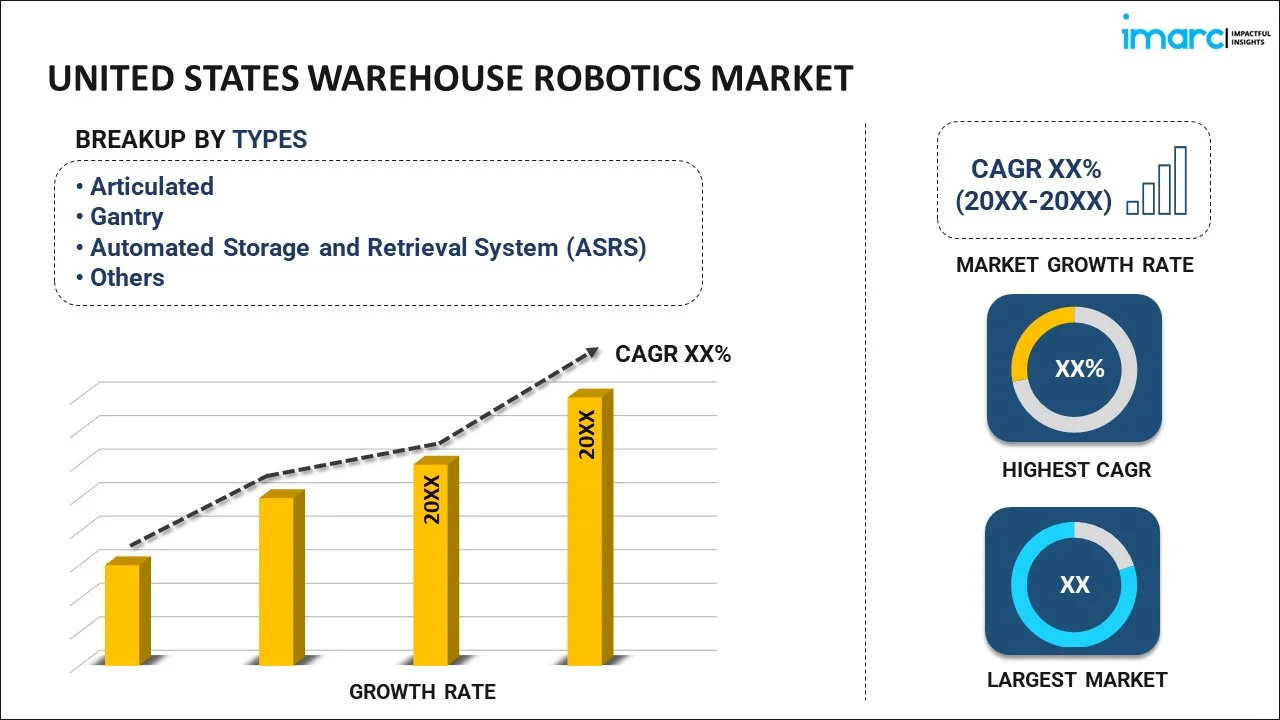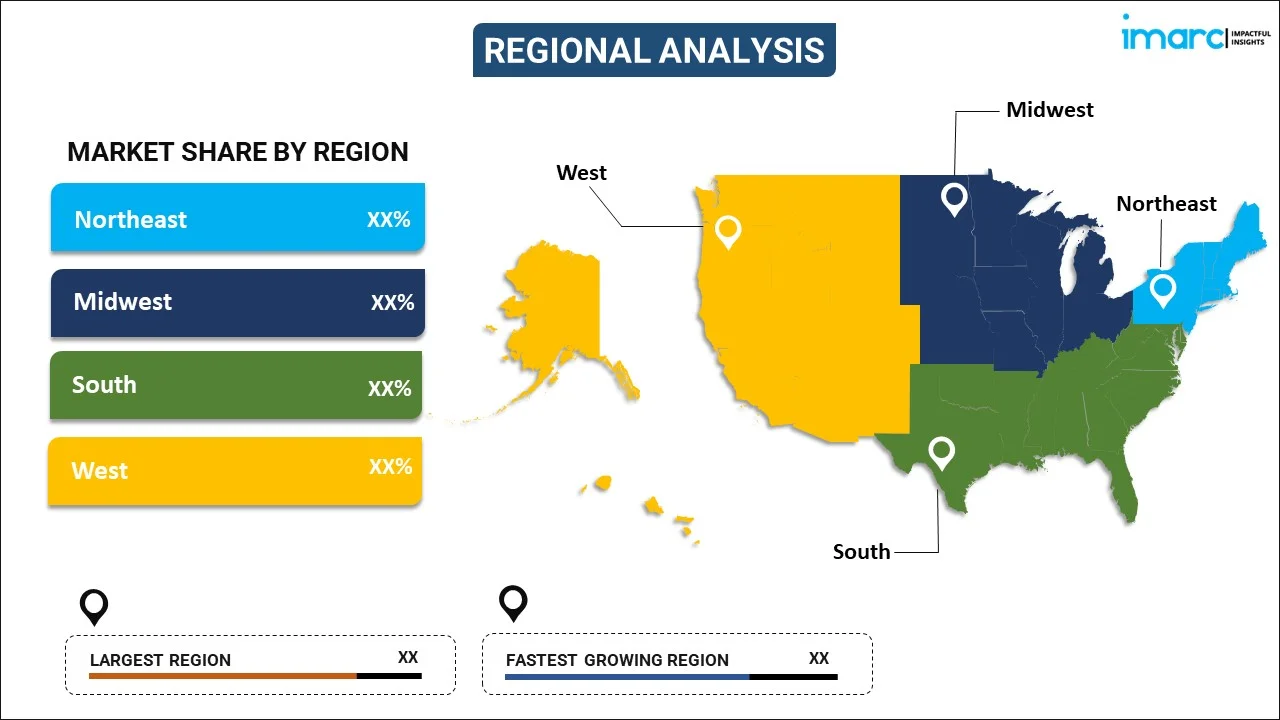
United States Warehouse Robotics Market Report by Type (Articulated, Gantry, Automated Storage and Retrieval System (ASRS), Mobile, and Others), Function (Storage, Trans-Shipments, Packaging, and Others), End User (Food and Beverages, Automotive, Retail, Electronics and Electrical, Pharmaceuticals, and Others), and Region 2025-2033
Market Overview:
United States warehouse robotics market size is projected to exhibit a growth rate (CAGR) of 10.74% during 2025-2033. Continuous improvements in operational efficiency, cost-effectiveness, and agility, owing to the evolving demands of modern commerce, are primarily driving the market growth.
|
Report Attribute
|
Key Statistics
|
|---|---|
|
Base Year
|
2024 |
|
Forecast Years
|
2025-2033
|
|
Historical Years
|
2019-2024
|
| Market Growth Rate (2025-2033) | 10.74% |
Warehouse robotics is an automated solution controlled by computers, designed to streamline and optimize warehouse processes by facilitating the transportation of materials. This system employs specialized machinery and software solutions to enhance accuracy in tasks such as pick-place, packing, transportation, packaging, and palletizing of materials and products. Components of warehouse robotics encompass industrial robots, sortation mechanisms, conveyors, autonomous mobile robots (AMR), and automated storage and retrieval systems (AS/RS). Navigating through workspaces, these robots utilize computer systems, onboard sensors, magnetic strips, infrared cameras, and integrated maps to identify obstacles, avoid collisions, and efficiently transport inventory within the warehouse.
United States Warehouse Robotics Market Trends:
The United States warehouse robotics market is witnessing a transformative surge as automation technologies reshape the landscape of logistics and supply chain operations. Leveraging specialized machines and advanced software, these systems excel in tasks such as pick-place, packing, transportation, packaging, and palletizing, significantly enhancing operational accuracy, thereby acting as another significant growth-inducing factor. Additionally, the market encompasses a diverse range of technologies, including industrial robots, sortation mechanisms, conveyors, autonomous mobile robots (AMR), and automated storage and retrieval systems (AS/RS). Besides this, warehouse robotics in the U.S. navigates through workspaces utilizing sophisticated tools. These include computer systems, onboard sensors, magnetic strips, infrared cameras, and integrated maps, which enable efficient navigation, obstacle identification, collision avoidance, and seamless inventory movement within warehouse environments. Furthermore, the deployment of warehouse robotics translates into streamlined processes, minimizing redundancy, and offering a resilient solution to challenges posed by fatigue and wear and tear in traditional manual operations. Moreover, industries across the spectrum, including food and beverage, automotive, pharmaceuticals, and retail, are increasingly adopting warehouse robotics to optimize their supply chain logistics. This, in turn, is projected to fuel the regional market in the coming years.
United States Warehouse Robotics Market Segmentation:
IMARC Group provides an analysis of the key trends in each segment of the market, along with forecasts at the country level for 2025-2033. Our report has categorized the market based on type, function, and end user.
Type Insights:

- Articulated
- Gantry
- Automated Storage and Retrieval System (ASRS)
- Mobile
- Others
The report has provided a detailed breakup and analysis of the market based on the type. This includes articulated, gantry, automated storage and retrieval system (ASRS), mobile, and others.
Function Insights:
- Storage
- Trans-Shipments
- Packaging
- Others
A detailed breakup and analysis of the market based on the function have also been provided in the report. This includes storage, trans-shipments, packaging, and others.
End User Insights:
- Food and Beverages
- Automotive
- Retail
- Electronics and Electrical
- Pharmaceuticals
- Others
The report has provided a detailed breakup and analysis of the market based on the end user. This includes food and beverages, automotive, retail, electronics and electrical, pharmaceuticals, and others.
Regional Insights:

- Northeast
- Midwest
- South
- West
The report has also provided a comprehensive analysis of all the major regional markets, which include Northeast, Midwest, South, and West.
Competitive Landscape:
The market research report has also provided a comprehensive analysis of the competitive landscape in the market. Competitive analysis such as market structure, key player positioning, top winning strategies, competitive dashboard, and company evaluation quadrant has been covered in the report. Also, detailed profiles of all major companies have been provided. Some of the key players include:
- FANUC America Corporation
- Fetch Robotics Inc. (Zebra Technologies Corporation)
- Honeywell International Inc.
- KUKA Robotics Corporation
- Omron Corporation
(Please note that this is only a partial list of the key players, and the complete list is provided in the report.)
United States Warehouse Robotics Market Report Coverage:
| Report Features | Details |
|---|---|
| Base Year of the Analysis | 2024 |
| Historical Period | 2019-2024 |
| Forecast Period | 2025-2033 |
| Units | Million USD |
| Scope of the Report | Exploration of Historical and Forecast Trends, Industry Catalysts and Challenges, Segment-Wise Historical and Predictive Market Assessment:
|
| Types Covered | Articulated, Gantry, Automated Storage and Retrieval System (ASRS), Mobile, Others |
| Functions Covered | Storage, Trans-Shipments, Packaging, Others |
| End Users Covered | Food and Beverages, Automotive, Retail, Electronics and Electrical, Pharmaceuticals, Others |
| Regions Covered | Northeast, Midwest, South, West |
| Companies Covered | FANUC America Corporation, Fetch Robotics Inc. (Zebra Technologies Corporation), Honeywell International Inc., KUKA Robotics Corporation, Omron Corporation etc. |
| Customization Scope | 10% Free Customization |
| Post-Sale Analyst Support | 10-12 Weeks |
| Delivery Format | PDF and Excel through Email (We can also provide the editable version of the report in PPT/Word format on special request) |
Key Questions Answered in This Report:
- How has the United States warehouse robotics market performed so far and how will it perform in the coming years?
- What has been the impact of COVID-19 on the United States warehouse robotics market?
- What is the breakup of the United States warehouse robotics market on the basis of type?
- What is the breakup of the United States warehouse robotics market on the basis of function?
- What is the breakup of the United States warehouse robotics market on the basis of end user?
- What are the various stages in the value chain of the United States warehouse robotics market?
- What are the key driving factors and challenges in the United States warehouse robotics?
- What is the structure of the United States warehouse robotics market and who are the key players?
- What is the degree of competition in the United States warehouse robotics market?
Key Benefits for Stakeholders:
- IMARC’s industry report offers a comprehensive quantitative analysis of various market segments, historical and current market trends, market forecasts, and dynamics of the United States warehouse robotics market from 2019-2033.
- The research report provides the latest information on the market drivers, challenges, and opportunities in the United States warehouse robotics market.
- Porter's five forces analysis assist stakeholders in assessing the impact of new entrants, competitive rivalry, supplier power, buyer power, and the threat of substitution. It helps stakeholders to analyze the level of competition within the United States warehouse robotics industry and its attractiveness.
- Competitive landscape allows stakeholders to understand their competitive environment and provides an insight into the current positions of key players in the market.
Need more help?
- Speak to our experienced analysts for insights on the current market scenarios.
- Include additional segments and countries to customize the report as per your requirement.
- Gain an unparalleled competitive advantage in your domain by understanding how to utilize the report and positively impacting your operations and revenue.
- For further assistance, please connect with our analysts.
 Request Customization
Request Customization
 Speak to an Analyst
Speak to an Analyst
 Request Brochure
Request Brochure
 Inquire Before Buying
Inquire Before Buying




.webp)




.webp)












